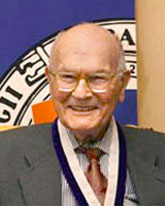Hobart Medal of Excellence
Harry W. Coover, Jr. '41 P'66
Chemist; Inventor of Super Glue

While much attention was given to the glue's capacity to bond solid materials, Coover was also the first to recognize and patent cyanoacrylates as a tissue adhesive and hemostat. It was used as a hemostatic spray during the Vietnam War to temporarily patch the internal organs of injured soldiers until conventional surgery could be performed, tissue adhesives are now used worldwide for a variety of sutureless surgical applications.
Coover held 460 patents, and Super Glue was just one of his many discoveries. He viewed "programmed innovation," a management methodology emphasizing research and development, among his most important work. Implemented at Kodak, programmed innovation in 1980 through 1984 at Eastman Chemical Division resulted in the introduction of 320 new products and sales growth from $1.8 billion to $2.5 billion. Coover later formed an international management consulting practice, advising corporate clients around the world on programmed innovation methodology.
Coover received the Southern Chemist Man of the Year Award for his outstanding accomplishments in individual innovation and creativity. He also received the Earle B. Barnes Award for Leadership in Chemical Research Management, the Maurice Holland Award and was a medalist for the Industrial Research Institute. In 2004, Coover was inducted into the National Inventor's Hall of Fame in Akron, Ohio, where he joined the ranks of such inventors as Alexander Graham Bell, Henry Ford and Thomas Edison.
He received his B.S. from Hobart before earning his M.S. and Ph.D. from Cornell University.
